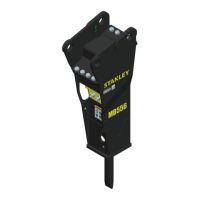12 ► MB556 User Manual
amount of down pressure being applied and be able
to adjust it if necessary. Not enough down pressure
results in low production and accelerates wear and tear
on the equipment. Too much down pressure may cause
the breaker housing to violently crash into the broken
material when “break-through” occurs.
In any breaking job, the operator should make every
eort to “follow” the breaker with “down pressure” as the
machine breaks farther into the material. The breaker
should be stopped as soon as “break-through” occurs or
if it is apparent that good solid blows are not occurring.
BREAKING
The operator should note the sound of the blow when
the breaker is running. With experience, the operator
will be able to tell the dierence between a good solid
blow and a hollow sounding blow. A hollow blow means
that solid blows are not occurring and breaker should be
repositioned.
Continuous tool penetration usually does not do much
good. If the material does not break with 3–6 inches
of tool penetration, it usually won’t break with full
penetration. The time used for additional penetration
could be better used to strike blows in another place.
Many materials do not respond well to continued
hammering in one place. The breaker tool should be
repositioned on the work each time the tool penetrates
but does not crack the material.
Do not break continuously
in one place.
Do not break continuously
in one place
Figure 7. Breaking
Continuous penetration in the same area for lengthy
periods will create excessive temperatures at the tip
of the tool bit resulting in loss of temper (hardness)
of the bit, mushrooming of the tip of the bit and may
lead to failure of the bit.
Use a “scoring” method of breaking when cracking the
material becomes dicult. This technique involves
striking the rock or concrete at several places along a
line where you want the crack to occur. Most materials
break sooner when struck several places along a line
than when struck repeatedly in one location. On each
line, the breaker tool should be continually repositioned.
Practice determines the best length of time to stay in
one spot (15–20 seconds) and how far to move the
breaker tool.
Figure 8. Scoring with the Breaker
Breaker tool binding can cause erratic breaker operation
and premature wear on the tool shank. Breaker tool
binding is caused by failure to direct the down force in
the direction of the tool bit.
OPERATION

